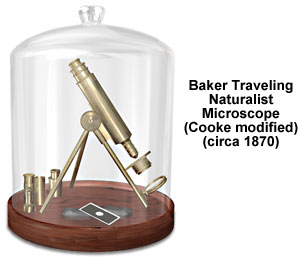Baker Naturalist's Traveling Microscope
Although Charles Baker of London marketed it as the naturalist's traveling microscope in their 1868 catalogue, Mordecai C. Cooke, a famous British mycologist and founding member of the Quekett Microscopical Club, commissioned William Moginie to design this special edition, which became his favorite laboratory instrument. Gerard Turner describes his discovery of the microscope at the Royal Horticultural Society's Garden at Wisley in his book Essays on the History of the Microscope.

Over a 30-year period, Cooke, who often worked in conjunction with a camera lucida, completed about 15,000 drawings of fungi that were examined under this brass, monocular microscope. The instrument is stored under a bell jar with a wooden base and includes a Powell & Lealand 0.25-inch objective, a Hartnack 0.125-inch objective, and a shallow eyepiece with a slot for an ocular micrometer. The illumination system of the microscope features a single, substage concave mirror and an achromatic condenser. The 226-millimeter body tube of the portable instrument is supported by long, folding tripod legs. Mounted on one of the legs is a short bar that carries the pinion for the coarse focus mechanism. A fine focus mechanism is lacking, but inside the body tube is a drawtube.
The rectangular stage of the microscope is very basic, but bears a condenser collar on its underside. Although it is not illustrated here, a rectangular plate that dovetails over the fixed stage can carry accessories, such as a square aperture, a slide support bar, two spring clips, and holes for optional equipment. There is also an insertion hole between the rackwork and the stage for a bull's-eye condenser to be used for illumination of opaque objects. A stage micrometer that consists of a glass slide covered with red paper, divided into tenths of a millimeter, is illustrated above on the wooden stand (beneath the tripod).
J. Newton Tompkins first described this instrument in an 1867 article published in the Journal of the Royal Microscopical Society entitled "On a Travelling Microscope." The popular design was copied by Baker competitors, such as the London firm Watson & Son, and sold as "The Traveller's Microscope" for a little more than 2 pounds. The Wisley Gardens instrument featured here was sold for 10 pounds to the Royal Horticultural Society by Cooke a year before his death in 1914.
BACK TO NINETEENTH CENTURY MICROSCOPES
